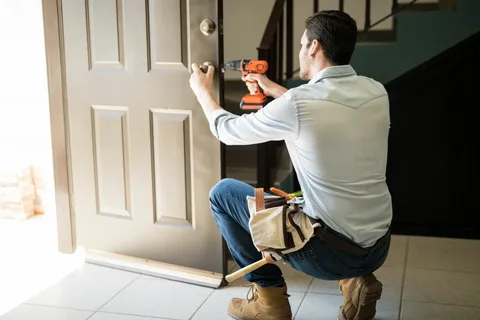Energy efficiency is a key concern for homeowners, not only because it reduces utility bills but also because it contributes to a sustainable and environmentally friendly lifestyle. One of the most overlooked factors that significantly impact energy efficiency is the condition and installation of your doors. Proper door installation is essential for minimizing heat loss, preventing drafts, and maintaining a comfortable indoor environment.
In this article, we will explore how correctly installed doors can improve energy efficiency, the consequences of poor installation, and best practices for ensuring your doors perform optimally.
1. Doors as Critical Barriers to Energy Loss
Doors are more than just entry points; they are vital barriers that separate indoor and outdoor environments. When doors are not installed correctly, gaps and misalignments allow air to escape or enter your home, causing:
-
Increased heating and cooling costs
-
Uneven indoor temperatures
-
Reduced comfort for occupants
With proper door installation, the door fits securely within the frame, forming a tight seal that prevents air leaks and energy loss, helping your HVAC system work more efficiently.
2. Preventing Drafts and Air Leaks
One of the most common energy efficiency issues in homes is air leakage around doors. Drafts not only make indoor spaces uncomfortable but also force heating and cooling systems to work harder. Proper door installation ensures:
-
The door aligns perfectly with the frame
-
Weatherstripping is correctly applied
-
Thresholds are sealed and fitted properly
By eliminating drafts, homeowners can maintain a consistent indoor temperature and reduce reliance on heating and cooling systems, ultimately lowering energy consumption.
3. Enhancing Insulation Performance
Energy-efficient doors are often designed with insulated cores, but these features are only effective when paired with proper door installation. Improperly installed doors can:
-
Compromise the insulation by allowing air infiltration
-
Create thermal bridges where heat escapes
-
Reduce the effectiveness of energy-efficient glass panels or materials
Professional installation ensures that the door’s insulation capabilities are fully realized, maintaining energy savings and a comfortable indoor environment.
4. Reducing Strain on HVAC Systems
When doors are poorly installed, HVAC systems must work harder to compensate for lost air, leading to:
-
Higher energy bills
-
Increased wear and tear on equipment
-
Reduced lifespan of heating and cooling systems
By investing in proper door installation, homeowners help their HVAC systems operate more efficiently, saving money on energy costs and preventing costly repairs or premature replacement.
5. Maintaining Indoor Comfort
A door that is misaligned, warped, or improperly sealed can lead to cold spots in winter and hot spots in summer. This inconsistency makes it difficult to maintain a comfortable indoor temperature. Proper door installation ensures:
-
Uniform indoor temperatures
-
Minimization of hot or cold spots near entryways
-
Increased overall comfort for the household
A well-installed door works in harmony with your home’s insulation, contributing to a pleasant and energy-efficient living environment.
6. Maximizing the Efficiency of Energy-Efficient Doors
Modern doors often feature energy-saving materials, including:
-
Insulated cores and foam cores
-
Low-emissivity (Low-E) glass
-
Composite or fiberglass panels with high thermal resistance
These features are only effective if the door is installed correctly. Professional proper door installation ensures that:
-
Insulated panels are not compromised by gaps or misalignment
-
Low-E glass is properly sealed to prevent heat transfer
-
Door frames provide structural support without allowing air leaks
By combining energy-efficient materials with proper installation, homeowners can maximize their investment and reduce energy waste.
7. Reducing Moisture and Condensation Issues
Improper door installation can also lead to moisture infiltration, which not only affects energy efficiency but also causes damage to walls, floors, and door frames. Moisture can lead to:
-
Mold and mildew growth
-
Rotting of wooden frames
-
Increased humidity that forces HVAC systems to work harder
With proper door installation, doors are sealed and aligned correctly, preventing moisture entry and maintaining energy efficiency while protecting your home’s structural integrity.
8. Improving Home Value
Energy efficiency is a key selling point for modern homes. Homes with well-installed, energy-efficient doors are more attractive to potential buyers because they:
-
Offer lower utility bills
-
Provide a comfortable indoor environment
-
Demonstrate attention to home maintenance and quality
Investing in proper door installation enhances your home’s market value while contributing to long-term energy savings.
9. Compliance with Building Codes and Standards
Many building codes and energy efficiency standards require doors to meet specific criteria. Professional installers ensure that proper door installation meets these regulations, including:
-
Minimum insulation requirements
-
Proper sealing to prevent air leakage
-
Correct installation of weatherstripping and thresholds
Compliance not only avoids potential fines but also guarantees that your home achieves optimal energy efficiency.
10. Reducing Environmental Impact
Energy-efficient homes reduce greenhouse gas emissions and environmental impact. Poorly installed doors contribute to energy waste, which increases your carbon footprint. By ensuring proper door installation, homeowners can:
-
Reduce energy consumption
-
Minimize unnecessary HVAC operation
-
Support sustainable living practices
A properly installed door is a small but impactful step toward a greener, more sustainable home.
11. Minimizing Long-Term Costs
While professional door installation may require an upfront investment, it saves money in the long run by:
-
Lowering energy bills through better insulation and sealing
-
Preventing frequent repairs due to air leaks or warping
-
Extending the lifespan of doors and HVAC systems
The initial cost of hiring professionals for proper door installation pays off through energy savings and reduced maintenance expenses.
12. Tips for Ensuring Proper Door Installation
To maximize energy efficiency, consider these tips when installing doors:
-
Hire professionals: Experienced installers guarantee accurate measurements, alignment, and sealing.
-
Choose energy-efficient doors: Look for doors with insulated cores, Low-E glass, and durable materials.
-
Check weatherstripping and thresholds: Ensure seals are tight and continuous.
-
Inspect for gaps: Even small gaps can compromise energy efficiency; fill or adjust them as needed.
-
Maintain regularly: Inspect doors periodically for wear, cracks, or seal deterioration.
Following these practices ensures that your doors perform efficiently for years to come.
Conclusion
Doors are a critical component of your home’s energy efficiency. Poorly installed doors can lead to drafts, heat loss, increased energy bills, and reduced comfort. Proper door installation addresses these issues by ensuring a perfect fit, effective sealing, and optimal use of energy-efficient materials.
Investing in professional installation provides numerous benefits, including improved insulation, reduced strain on HVAC systems, moisture prevention, and enhanced home value. Beyond financial savings, proper installation contributes to environmental sustainability by reducing energy waste and greenhouse gas emissions.
Whether you’re replacing old doors or installing new energy-efficient models, prioritizing proper door installation is essential for creating a comfortable, secure, and energy-efficient home. By taking this step, homeowners can enjoy long-term cost savings, peace of mind, and a more sustainable living environment.



